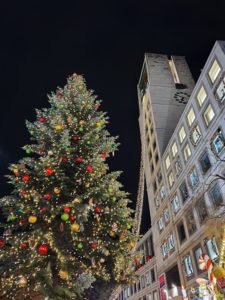Public Affairs
U.S. Army Garrision Stuttgart

Pandemic-related public health restrictions and the consequent cancellation of many Christmas markets and related events have, admittedly, put a damper on the 2020 holiday season. But before writing it off as a loss, consider learning about (or adopting) some of the traditions that make Germany such a magical place to be around this time!
The official start of the holiday season for Germans is on the first of four Advent Sundays. Families gather around a decorated wreath with four candles, called “Adventskranz,” and light a new candle every Sunday until all four are burning. The afternoons are an opportunity to enjoy an “Adventskaffee” (coffee) with cake or home-baked “Weihnachtsplätzchen” (Christmas cookies).
Children have Advent calendars that are filled with sweets or small gifts to open each day until December 24 to make the waiting period seem shorter.
One old tradition is cutting a few branches of trees like apple or cherry on December 4 and putting them in a vase filled with water. December 4 is Barbaratag, named after the martyr St. Barbara, who died in the third century. If all goes right, the branches will bloom by Christmas Eve, not only bringing color and fragrance into the house, but also serving as a good-luck charm for the coming year.
Additionally, people in parts of Southwest Germany long took delight in forecasting the weather for the coming year with a “Zwiebelkalender,” or onion calendar. Start the process by cutting an onion into 12 slices and lay them in a row, each slice representing one of the 12 months. Sprinkle the slices with salt, and then watch which slice “weeps” the most juice: That will be the rainiest month of the coming year.
There is, in fact, a whole string of traditions associated with the 12 Days of Christmas, also known as “Rauhnächte,” or rough nights, from December 25 to January 6. In olden days, people in some areas of Southern Germany used to avoid doing everyday chores during this time, concerned that spirits and ghouls could swoop through the air disturbing them. Even until recently, people in the countryside would dress up in devils’ costumes to dance away whatever fiends might be lurking around after New Year’s Day.
Masked dancers, known as “Perchten,” or wild spirits, in Bavaria and Austria, are still said to leap about in barren, snowy fields to make them fertile, or they visit farmhouses led by a rider on a white horse. According to legend, they dance until a witch comes with a broom to sweep them away, appearing alone or in groups during the Rauhnächte. They also carry bells and various loud instruments to dispel the winter.
The holiday season comes to an official end on January 6, a German holiday known as “Dreikönigstag” (Three Kings Day or Epiphany).
